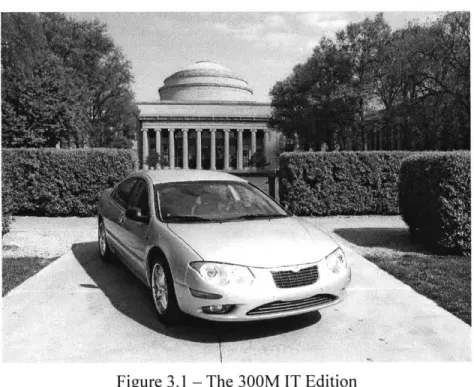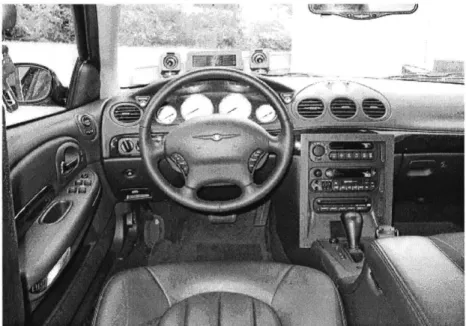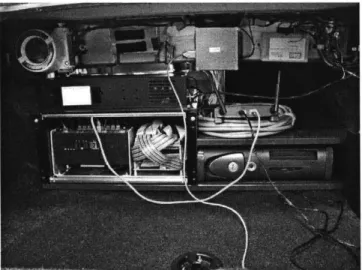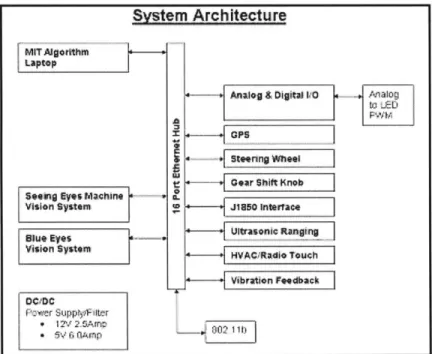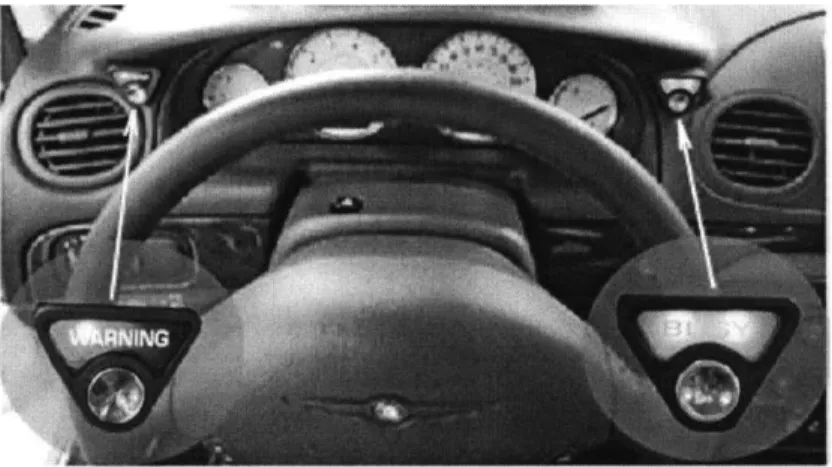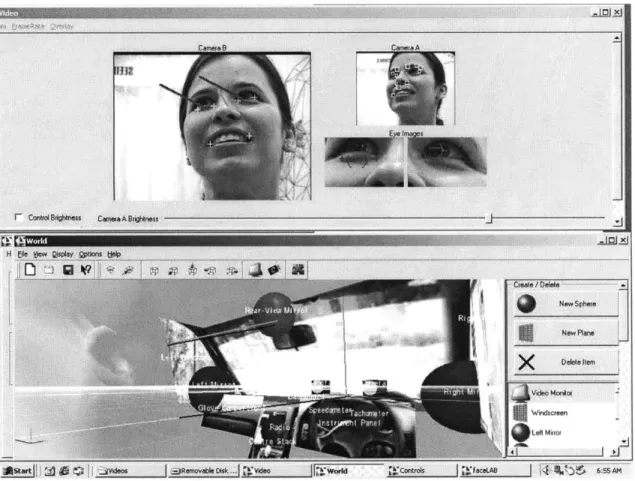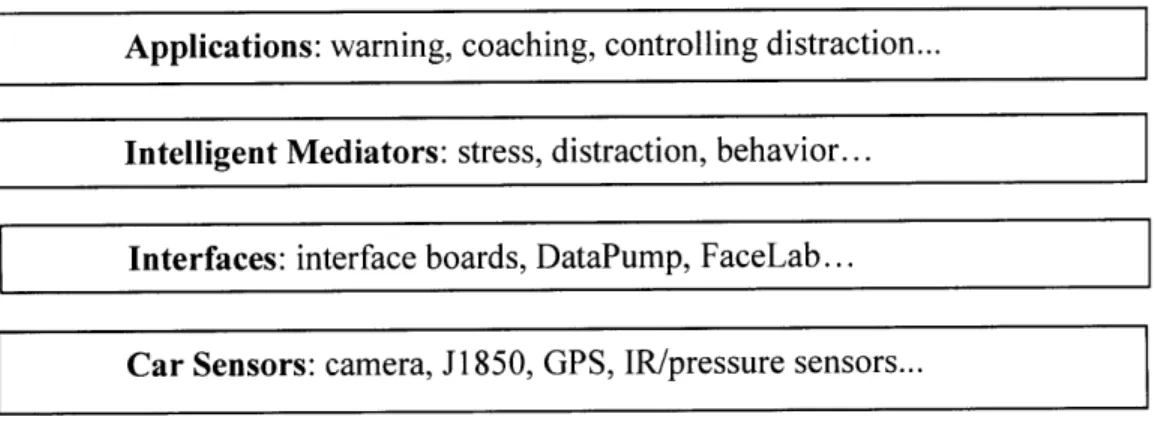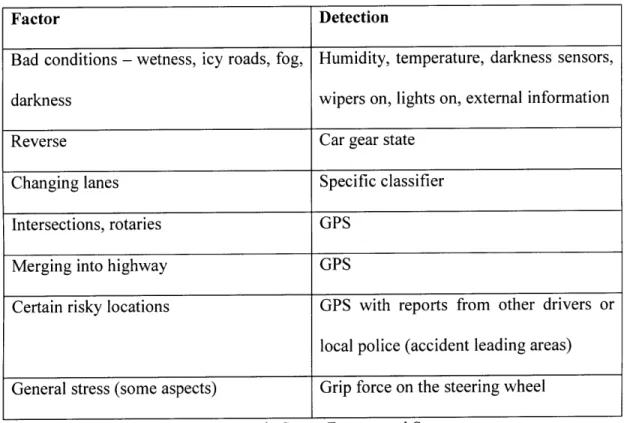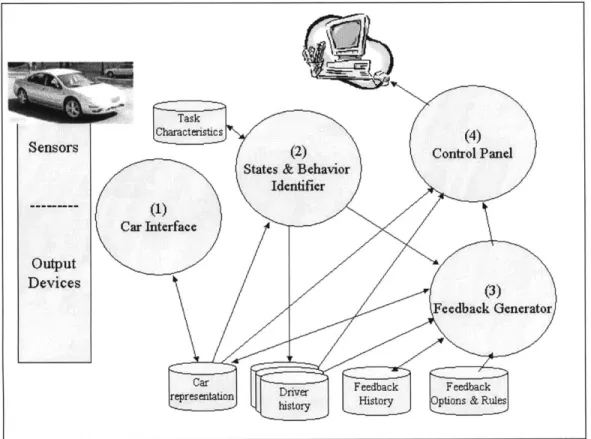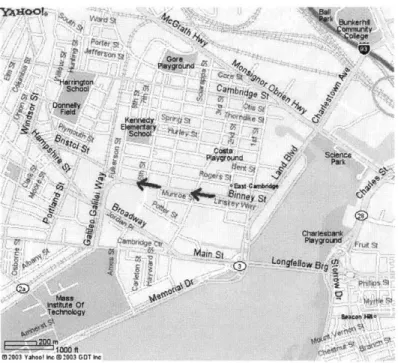An Advanced Driver Warning Framework
Incorporating Educational Warnings
by Taly Sharon
Submitted to the Program in Media Arts and Sciences School of Architecture and Planning
In partial fulfillment of the requirements for the degree of Master of Science in Media Arts and Sciences
MAS At the Massachusetts Institute of Technology
June 2003
C 2003 Massachusetts Institute of Technology
Signature of Author
SACHUSETTS INSTITUTE OF TECHNOLOGY
JUL 1 4 2003
LIBRARIES
Program in Media Arts and Sciences May 9, 2003
-711
Certified by
Ted Selker Associate Professor of Media Arts and Sciences Thesis Supervisor
Certified by
Dan Ariely Associate Professor of Media Arts and Sciences
Thesis Supervisor Accepted by Departmental Committee Andrew B. Lippman Chairperson on Graduate Students
ROTCH
An Advanced Driver Warning Framework
Incorporating Educational Warnings
by Taly Sharon
Submitted to the Program in Media Arts and Sciences School of Architecture and Planning
In partial fulfillment of the requirements for the degree of Master of Science in Media Arts and Sciences
Abstract
Car accidents are a serious problem. The measures currently being taken are not very successful in preventing accidents. To reduce the number of accidents, driver support and warning systems are built. Part of their solution is the use of education, in the form of educational warning systems. However, issuing warnings might distract the driver from the driving task exactly when the stress level is high and immediate action is required. This work concentrates on educational warning systems in the framework of cars and driving. It proposes an innovative design that is demonstrated via a prototype of an educational warning system. One of the main objectives of the research presented here is to test if delaying warnings and feedback (to prevent stress and distraction) improves the learning ability and the performance of drivers using them.
Are delayed (educational) warnings superior to immediate warnings? Using the 300M IT Edition, an experiment to test the effects of delayed feedback on the learning process in two driving tasks was carried out. The findings showed significant evidence of better performance overall, while yielding marginal significant of improvement in task understanding, and some indication, although not significant, of faster and stronger improvement in task performance of the delayed feedback group. The main impact of the work is some evidence that delayed warnings in driver learning tasks are superior. More importantly, it is not evident that it is inferior, which makes it preferable to immediate feedback that may distract the driver from the driving task.
Thesis Supervisors: Ted Selker, Dan Ariely Associate Professors of Media Arts and Sciences
An Advanced Driver Warning Framework
Incorporating Educational Warnings
by Taly Sharon
Thesis reader
Rosalind W. Picard, Sc.D. Associate Professor of Media Arts and Sciences MIT Media Laboratory
An Advanced Driver Warning Framework
Incorporating Educational
by Taly Sharon
Warnings
Thesis reader
Clifford A. (Chip) Wood Principal Scientist, Human Factors Motorola Labs-Human Interface Lab
Acknowledgements
Many people have helped me in this research undertaking, as well as through the course of my studies. I'd like to heartily thank them all.
Ted Selker, for supporting and encouraging my work, and for all the time and effort he put into the 300M car and CarCoach.
Dan Ariely, for his amazing contribution to my experimental design, to analyzing the results, and in his encouragement to complete this research.
Roz Picard, for helping me throughout my studies and in this research, and in giving me valuable feedback.
Chip Wood, for helping me to focus this work, giving me sound advice, especially during the experiment and the professional contribution - straight out of the industry. Steve Buckley (DaimlerChrysler) and Jim Kemp (Motorola), for their support and help in setting up the 300M car and the equipment needed for my research.
All the people who helped with the car and the hardware and software in it, including Paul Selker, Ernesto Arroyo, Kim May, Jean B. Almonord, Nathan Ackerman, Ian Berlinsky, Karen Liu, Ryan Chin, and Lars Wagner.
Nina Mazar, for her invaluable help in the analysis of the research results.
Ariel Frank, for virtually holding my hand, encouraging, advising, and reviewing my work before and during this course of study, and hopefully after ...
Betty Lou McClanahan, for always giving a helping hand and making sure I get relaxed over the best coffee and cookies around!
Special thanks also to Henry Lieberman, for being a mentor, guiding and helping me in my studies and projects.
The Context Aware Computing group members, Ernesto Arroyo, Win Burlson, Connie Cheng, Andrea Lockerd, David Merrill, Matt Mankins, and Heidi Polsen, for being there for me, professionally and personally.
My family, Michael and Eden, and the forthcoming baby that is already kicking inside to rush me to finish on time, my mom, Yoela, my brothers Guy, Roy, and Arik. All of you who were always there for me and helped me to pull this through! I love you all!
An Advanced Driver Warning Framework
Incorporating Educational Warnings
Contents
A bstract ...
2
A cknow ledgem ents... 5
Contents ... 6
List of Figures ... 7
List of Tables ... 8
1. Introduction... 9
2. Technology A pproaches for R isk Reduction... 13
D river Support and W arning system s ... 13
Educational W arnings... 14
Stress R eduction... 16
D elaying W arnings and Learning ... 19
3. R esearch Platform - The 300M IT Edition... 22
4. Educational W arning S D ... 29
Intelligent Layered A rchitecture ... 30
Softw are D esign ... 34
Prototype: CarCoach... 39
5. Experim ent... 44
The Experim ent Softw are ... 45
The Subjects ... 47 The Location/Route ... 48 The Procedure ... 50 6. R esults... 52 The Subjects ... 52 Task U nderstanding ... 53
O verall Perform ance ... 54
Im provem ent ... 58
Q uestionnaire ... 66
O bservations ... 68
7. Conclusions and Future D irections ... 70
Conclusions... 70
Future D irections ... 71
Bibliography ... 74
Term s and A cronym s... 77
A ppendix A : M IT D riving Study Consent Form ... 78
A ppendix B: Q uestionnaire... 79
List of Figures
Figure 3.1 - The 300M IT Edition... 22
Figure 3.2 - The 300M IT Edition Interior... 23
Figure 3.3 - The 300M IT Edition Sensors Location ... 24
Figure 3.4 - 300M IT Edition Trunk Computation Center... 24
Figure 3.5 - 300M IT Edition Architecture... 25
Figure 3.6 - Example HTTP Setup Page of the J1850 ... 25
Figure 3.7 -Light on the Right Mirror... 26
Figure 3.8 -Light on the Car Side ... 26
Figure 3.9 -Busy and Warning Lights/Buttons ... 26
Figure 3.10 -Facelab Software with an Active World Model... 28
Figure 4.1 -Intelligent Layered Architecture ... 31
Figure 4.4 -Software design of Educational Warning System... 35
Figure 5.2 - Experiment Software Interface... 46
Figure 5.5 - R ecruiting Poster ... 48
Figure 5.6 -Acceleration Task Area... 49
Figure 5.7 -Turn Task A rea ... 50
Figure 5.8 -Alternative Turn Task Area ... 51
Figure 6.1 - Acceleration and Turn Task Descriptions Multiple-choice Questions Success ... 5 3 Figure 6.4 - Average Turn Failures and Acceleration Successes... 56
Figure 6.5 - Acceleration Average Performance... 56
Figure 6.8 - Average Success in Each Repetition of the Turn Task ... 58
Figure 6.14 - Performance in the First vs. Second, First vs. Last Acceleration... 65
List of Tables
Table 4.2 - Example Stress Factors and Sensors... 33
Table 4.3 - Example Distraction Factors and Sensors ... 33
Table 4.5 -CarCoach Sensors and Effectors ... 40
Table 4.6 -C arCoach Scenarios... 41
Table 4.7 -CarCoach Effectors M odel... 42
Table 5.1 -Softw are Param eters ... 46
Table 5.3 -Acceleration Task A lgorithm ... 47
Table 5.4 -Turn Task A lgorithm ... 47
Table 6.2 - Accel. and Turn Task Desc. Multiple-choice Questions Success Means... 54
Table 6.3 - Accel. and Turn Task Descr.Multiple-choice Questions Success t-values ... 54
Table 6.6 - Average Turn Failures, Acceleration Successes and Performance Means.... 57
Table 6.7 -Average Turn Failures, Acceleration Successes and Performance t-values.. 57
Table 6.9 - Average Success in Each Repetition of the Turn Task Means... 59
Table 6.10 - Average Success in Each Repetition of the Turn Task t-values ... 60
Table 6.12 - Average Performance in Each Repetition of the Acceleration Task Means 62 Table 6.13 - Average Performance in Each Repetition of the Acceleration Task t-values ... 6 4 Table 6.15 - Performance in the First vs. Second, First vs. Last Acceleration Means .... 65
Table 6.16 - Performance in the First vs. Second, First vs. Last Acceleration t-values .. 66
Table 6.18 -Questionnaire (Likert Scale) Means ... 67
1. Introduction
Motor vehicle crashes are the leading killer of Americans between the ages of one and 29. For example, in 1999, an average of 112 people were killed in motor vehicle crashes every day - one every 13 minutes. While the greatest cost is incalculable human suffering and loss, motor vehicle crashes also cost Americans an estimated $192.2 billion in 1999. The largest expenses in this loss were $66.4 billion in lost wages and reduced productivity, $45.8 billion in property loss, and $20.7 billion in medical expenses. Numbers this large tend to be incomprehensible. For a perspective, the total amount of money 'consumed' by motor vehicle crashes amounts to 75 cents of every dollar spent by individuals for transportation in 1999 [NSC 2000].
Moreover, the US Department of Transportation safety programs were unable to meet their own fatalities reduction targets. For example, in 2002, the target rate of reduction of highway fatalities was 1.4 fatalities per 100 million vehicle-miles traveled. However, this target was not met, and the actual estimated rate was 1.5 [BTS1 2002].
This is caused partially by the fact that many licensed drivers are not good drivers -some have forgotten the rules over time; others have developed bad habits along the way; and they often drive in an automatic-unconscious manner [Nardi 1997].
Therefore, to cope with this severe problem, driver support and warning systems are being built (for example, see [Michon 1993]). For example, it has been suggested that technological solutions can provide feedback on driving ability, warn about dangers, and
However, even though more and more safety systems are being installed in cars, such as ABS, they may actually increase the chances of crashing rather than reducing it. This is because the drivers learn the improved braking ability of the car, and even push it to its limits [ABS 2001]. According to the Risk Homeostasis Theory (RHT) [Gibson & Crooks 1938] people keep their risk level constant - they decide what is the level of risk they want to take, and keep it the same even when systems improve the car's safety [Gibson & Crooks 1938]1:
"More efficient brakes on an automobile will not in themselves make driving the automobile any safer. Better brakes will reduce the absolute size of the minimum stopping zone, it is true, but the driver soon learns this new zone and, since it is his field-zone ratio which remains constant, he allows only the same relative margin between field and zone as before."
This suggests that in addition to safety systems, warning and education systems are required. A special type of warning is performance warnings that are meant to continuously monitor and train drivers to drive at their best. The assumption is that these systems can improve the overall skill of a driver in all cases and that by this overall improvement, they could also facilitate either a better response from the driver at the time of an emergency or reduce cognitive load during the emergency, in which case additional warnings could be useful and not taxing.
Educational warnings have been proposed as a useful and important approach [Sviden 1993, Janssen et. al. 1993, Groeger 1993]. In one such case, Groeger [1993] describes a
performance support system for drivers, which he terms "Personalized Support And Learning Module" (PSALM). Another example of a system with an educational purpose is proposed by Roadsafety [2002]. Roadsafety's system monitors the driver and provides educational feedback in the form of a beep whenever a certain G force is applied on the car. Despite their initial appeal, one of the main problems with these systems is that the complete feedback is not fully conveyed in real-time and as an outcome is presented to the user only long after the event.
Regardless of the type of system used, driving can be a stressful activity, in which the driver is exposed to distracting events such as changing surroundings, passengers, cellular phone calls, etc. There is a risk that these systems may cause more harm than good. In this case of stress, such warning systems can also present a paradoxical situation - the instant in time in which most of the warnings are needed (when the driver is in danger) can be the same exact instant in which the driver needs all his or her attentional and cognitive capacity to cope with the situation [Verwey 1993].
For illustration, imagine two cases: falling asleep on the wheel and skidding. If one falls asleep at the wheel and consequently the car drifts to the side, a warning can be very useful because it can wake up the driver and potentially prevent an accident. On the other hand, if one starts to skid, while being fully awake, additional alerts from the warning systems might load the driver, which might ultimately reduce his or her ability to safely get out of the skid. It is this type of cases in which warning systems might be less efficient and could potentially cause more harm than good.
One solution to this problem is to delay the warnings when the driver is overloaded [Verwey 1993]. There has been some evidence from the field of education that delaying
feedback can even lead to better performance [Groeger 2000]. The current study proposes to examine some of the effects of warning systems in a driving situation by contrasting the effectiveness of on-time and delayed feedback in educational warning systems. The system proposed in this work will use short delays (5-10seconds) to provide feedback on deviant driving behavior. It is speculated that by using such a short delay, the system could both avoid the cognitive load problem mentioned earlier while at the same time also providing feedback that is easily associated with the events - allowing for faster learning.
The hypotheses here are that delayed (educational) warnings will be: 1) more effective in the short-run; 2) more effective in the long-run; and 3) allow faster learning.
This work is organized as follows:
e Chapter 2 establishes the basis for the research and provides a survey of the existing technologies for driving-related risk reduction.
* Chapter 3 describes the existing research platform used for the research, the 300M IT Edition. The 300M provided a basis for the development of a prototype of an educational warning system as well as a tool to carry out the experiment.
* Chapter 4 presents a design for an educational warning system and a prototype implemented to demonstrate the feasibility of this design.
" Chapter 5 describes the experiment carried out in order to learn how delayed (educational) warnings affect the learning process.
* Chapter 6 provides the results and their analysis.
2. Technology Approaches for Risk Reduction
Driver Support and Warning systems
Driver support systems have many functions. Janssen et. al. describe nine types of basic driver support functions (examples in parenthesis) [Janssen et. al. 1993]:
" Enhancing information (increasing visibility by retroflection). " Augmentation (special information about icy patches). * Warning (against speeding or other violations).
" Advice (to take a less congested route).
" Explanation (reason for delay, e.g., accident ahead). * Instruction (feedback about incorrect action). " Intervention (speed delimiter).
" Substitute or secondary control (cooperative driving). " Autonomous or primary control (robot driving).
One of the most beneficial driver support systems is warning systems. For example, important driver assistance and warning systems are Collision Avoidance Systems (CAS), Lane Departure Warning Systems (LDWS), Side Obstacle Warning systems (SOW) and Maneuvering Aids for Low Speed Operations (MALSO) [ISO 2001]. The purpose of CAS is to alert the driver to a hazardous situation requiring some action to avoid collision. SOW is intended to warn the driver against potential collisions with objects to the side of the vehicle, for instance in lane change maneuvers. MALSO are
detection devices, which are intended to assist the driver during low speed maneuvering, such as parking.
These warning systems require an immediate reaction from the driver to prevent accident. However, there are many other types of systems to support drivers, as listed above.
Educational Warnings
As part of the overall driver support systems, an educational system to support driver improvement has been envisioned. The most comprehensive design for an educational warning system was described as part of a large scale European project for Generic Intelligent Driver Support (GIDS). It was named Personalized Support And Learning Module (PSALM) [Groeger 1993]. PSALM was never implemented, but its principles
are still relevant [Groeger 2000]2:
"To improve driving performance by training, by increasing the amount and breadth of practice drivers have (different times, difficulties, with and without passengers), and by making this practice more systematic (e.g. graduated
reduction offeedback and instruction)."
The design of PSALM included driver profiles and driving tuning [Verwey et. al. 1993]3: "Storing the performance profiles of individual drivers, documenting the frequency with which they have encountered particular situations and their
history of 'abnormal'performance in each situation.
2 p.97
... For instance, abrupt hard braking, attempts to make fast and unusually large
steering corrections, excessive acceleration and adoption of highly variable headway."
PSALM was planned to include after-trip statistics and comments given to the driver after the driver reached a halt [Piersma et. al. 1993]. In addition, giving the driver real-time feedback, as well as premeditated training [Verwey et. al. 1993]:
"It seems probable that in the future PSALM may, once a criterion is exceeded, inform the driver that performance is not adequate, and suggest a local route, which requires performance of the relevant 'problem' activities".
PSALM design included user preferences in the form of a menu or by having the user talk to the computer to provide feedback orally ("Undesired", "Too early", "Too late") [Piersma 1993].
Unfortunately, the only function of PSALM that was implemented, as part of the European GIDS project, provided anticipatory spoken warnings regarding the upcoming traffic situation (e.g., "Round-about ahead", "Obstacle ahead") - intended to be used by novice drivers [Piersma et. al. 1993].
A full implementation of an educational warning system could benefit the entire population, especially in the injury prone groups such as younger and older people. It is a fact that especially younger (16-24 years) and older (over 64) people have higher involvement in car accidents and higher fatalities rates than the rest of the population [USFHA 1998, USFHA 2000]. The young population requires more training, and the older population requires reminders and maintenance of their driving skills. This is true
especially considering the fact that most drivers overestimate their driving abilities [Groeger 2000]4:
"Our sense of self-efficacy, while neither universally positive across all tasks, nor necessarily positive with respect to driving, is probably more positive than is warranted on the basis of our actual ability."
Stress Reduction
Driving is both a demanding and a stressful activity [Healey & Picard 2000, Groeger 2000, Michon 1993]. Driver support and warning systems help drivers but at the same time they can be distracting or irritating, especially when the stress level is high (such as in highway lane merging, etc.) [Wagner 2003].
Verwey [1993] suggested three ways of coping with stress and distraction:
1. Dynamic Allocation - use of dynamic allocation to remove tasks from the driver when the load is high, and return them when the load is lower.
2. Change - the warnings' modality, format, and content can be changed, for example by providing more information or additional details when the driver load is low.
3. Postpone (delay) or cancel - non-urgent warnings should be postponed or cancelled completely.
It is quite obvious that taking tasks off the driver as in dynamic allocation is desirable. Moreover, it might also be desirable to enable removing tasks from the driver upon his or her request, and not just according to the stress level. There are many tools to achieve this, some which already exist in the market, such as automatic transmission, cruise control, etc.; others, such as adaptive cruise control are currently under development. It is obvious that a lot of work is being done already in this area. Similarly, changing the modality, format and content of the messages is being extensively researched (see [ISO 2001, Tijerina et. al. 2000]). On the other hand, not much is known about delaying messages, especially in the driving environment.
Postponing (delaying) or canceling warnings
Several suggestions have been made in this direction. For instance, it has been suggested not to present messages when in curves [Piersma 1993]. PSALM was planned to provide on-line warnings, or feedback once the driver left the critical situation, or off-line messages when the driver reached a halt [Groeger 1993].
Sviden [1993] related to not overloading the driver with information. He suggested prioritizing and delaying messages according to list of priority groups he presented: * Safety: warning, advice, system status, tutoring.
* Traffic: guidance, rules and information, tutoring.
" Navigation: calculated arrival time at destination, street names and numbers. " Service Options: park-and-ride options, user charges, etc.
" Communication: business messages, private telephony, booking of services and commercial advertising.
However, it is not clear about the priorities in the groups listed above. Tutoring appears for example in two categories above (Safety and Traffic).
Wagner [2003] defined urgency of vehicle warnings by importing warning definitions from the aerospace industry. He defined three levels of messages: WARNING, CAUTION, and ADVISORY. About 15 warnings (mostly those presented to the driver in the instrument panel such as "low washing fluid", "low oil") were classified into these levels of warnings. He delayed CAUTION warnings when the driver is distracted (defined by the location or by some characteristics of the driving such as reverse, U turn, etc.) until not distracted, and disabled them completely from the instrument panel after the driver acknowledges them.
A more standard definition came from ANSI standards, which defined the following standard for communicating hazard in vehicles [Laux & Mayer 1993]:
1. DANGER: immediate hazard, which will result in severe injury or death.
2. WARNING: hazard or unsafe practice, which could result in severe injury or property damage.
3. CAUTION: hazard or unsafe practice, which could result in minor injury or property damage.
The problems in this definition are the following:
1. It is hard to measure the effect of each error (and hence classify a mistake to a group). A small mistake can result in death.
2. The classification does not relate to other types of messages, such as advisory educational, or navigation messages? These have no potential risk, only guidance.
Also, the ISO draft referred to this subject by suggesting to classify warnings according to a definition of the response time expected from the driver [ISOTC22 2002]: Immediate (immediate), Short term (10-20 seconds), and Long term (longer).
However, this ISO definition has its own problems:
1. Immediate is bounded by the Short term, and appears to be under 1 Os. In a driving situation, for immediate reaction, 0-1Os is a long time frame.
2. Long term relates to everything over 20s and is unbounded. There is a significant difference between seconds, minutes, hours, day and so forth. Maybe a more detailed classification is required.
3. The classification does not relate to warnings that do not require action from the driver. However, considering the proliferation of solutions and classification, regardless of their problems, there is still no answer here on how message delays can affect the driver.
Delaying Warnings and Learning
In the educational context it is important to know how delaying warnings and feedback to the driver can influence the learning process. There are three main timing options to when to give warnings: before, during, or after an action [Groeger 1993]. Each timing option has its benefit and drawbacks as follows:
1) Before - giving warning prior to an action can be very effective in preventing that action or mistake. However, forecasting actions is often impossible, thus the major risk associated with it is that it might be conceived as unrelated to current behavior, and would be irritating.
2) During (on-line) - giving warnings during the action is most technologically demanding, and may not be feasible except for very limited circumstances. Furthermore, it has the risk of dangerously distracting the driver.
3) After (called feedback/Knowledge of Result (KR)) - giving warnings after the action. This includes giving the feedback immediately after the action, or somewhat delayed.
" Immediately after - there is a risk of distracting the driver from the driving task, and also of making the driver reliant on that warning.
" Delayed -there is a risk that the driver will not understand the problem (especially in significant delays) especially in driving, which is a complex task where the circumstances can be different every time a specific feedback is given.
Focusing on the third and mostly feasible option, giving feedback after the action, knowledge collected about motor skills learning (not specifically driving) suggests that immediate feedback, regardless of its distracting effect, is not necessarily the most effective. Lorge & Thorndike [1935] studied motor skills of throwing balls onto a target while using delays of a few seconds (less than 10s). They found that delaying the KR, as long as not filled with similar activity, has no detrimental effect on learning.
In addition, immediate feedback may have the effect of guiding the performer, making the performer system dependent, rather than to let the performer develop an understanding of what behavior actually led to the feedback, [Groeger 1993]. Therefore,
there are even recommendations for graduated reduction of feedback and instruction to prevent such a dependency [Groeger 2000]5 .The explanations for this phenomenon are: - Extensive immediate feedback may mask/distract learner's attention away from the
task-intrinsic feedback.
- Less/withdrawn feedback encourages relying more on task-intrinsic feedback.
When studying withdrawn (intermittent) feedback the conclusions reached were that general or movement learning is better with intermittent feedback, while learning timing and force is better learned with feedback after each trial (for a full survey see [Groeger 2000]).
To summarize, it appears that delayed feedback in motor learning may have some advantages. However, it is not clear how these findings would apply to driving.
5 According to Groeger [2000], in the long run, less useful feedback or withdrawn feedback (called fading)
3. Research Platform
-
The 300M IT Edition
Since simulators do not provide as real an experience as driving cars [Denn 1994], the research platform is a real car, the 300M IT Edition (see Figure 3.1 for a picture of the car from the outside and Figure 3.2 for the interior). The 300M is a regular model offered by Chrysler, while the additional sensors and devices have provided us with this special model called the "IT Edition". The 300M IT Edition is a highly instrumented research vehicle equipped with many sensors and devices [Pompei et. al. 2002], as presented in Figure 3.3. The platform with all the sensors was fully available for this research, and in this work, only interfacing and debugging of it was carried out.
Figure 3.1 - The 300M IT Edition
The architecture and computation center is housed in the car's trunk (see Figure 3.4). It includes an 802.11 communication network with a wireless access point (see Figure 3.5). The architecture is flexible; its core is a set of NetBurners, which are programmable
boards connecting sensors and serial devices to the local Ethernet [NetBurner 2003]. They are configured here with either UDP or Telnet network protocol, as suitable for each device. At any time, one application computer can read the data from the devices by connecting to the network and setting up the boards to send UDP information to it through HTTP (see Figure 3.6 for an example setup page). Each relevant device in the car is described herein:
Engine data: speed, throttle position, brake pressure, RPM, etc. The access protocol is based on the J1850 protocol [J1850 2001].
* A set of sensors accessible via a steering angle, pressure sensors in pedals, cellular phone activity (and position on the pedals (including the
data acquisition board (nicknamed DataPump): the seats, cup holders, arm rests and all the car disabling) sensor, and infrared sensors for legs special dead-pedal to rest the left foot).
Figure 3.3 - The 300M IT Edition Sensors Location
System Architecture MIT Mgorithm
Laptop
Seeig eres Machine a -. Vision Systeom Blue Eyes ision System OC?0C fewer Supptilflter " 12VI 21Arnp " 5V 6 IAmp
Analog & Digital. WO Malog PWM
--- hGP
--- +J Inteace
002 11)
Figure 3.5 - 300M IT Edition Architecture.
Ble dt Vlew Faorts Ios ktielp
'Back ' I il earch -[Favores ESedia J J J
Address iehttp://192.168.1.10IANDEX.HTM
MOT'OROLA
AVT -J1850 Configuration Page NetBurnerFirmware Version: Beta 0.1.109, 8/6/2002
NetBurner IP: 192.168.001.010 Network Settings
Client IP 192.168.001.070 Debug Port05
Enable Debug Strean Enable Disable
AVT Filter Settings Fater Table Size: 1
Enable ASCII: B1 B2 B3 Prt.
... ... .. f( [..
--
---F
f~en
Figure 3.6 - Example HTTP Setup Page of the J1850
e Controllable lights on the mirrors and car sides (see Figures 3.7 and 3.8 respectively),
accessed via the DataPump.
r>Go
Subiit New Settings
sittteret
I !khttp:/J192.168.1.10/I -nL'=AU&dN1
Figure 3.7 -Light on the Right Mirror
Figure 3.8 - Light on the Car Side
e A Busy and a Warning (two colors - yellow and red) combination of lights and buttons, all accessible via the DataPump (see Figure 3.9).
* Vibrators in the steering wheel, driver seat, gas and brake pedals, and setup knobs, allowing affirmation and criticism intensity setup. They are built using a modified IRX [Poor 1999].
* Controllable standard lights in the instrument panel, such as signal, brake, fuel, and warnings.
* A set of cameras and FaceLab software for gaze tracking from SeeingMachines [SM 2003]. FaceLab can be interfaced via UDP and provides a full set of information items. It requires calibration for each driver using it. But first it requires a one-time construction of a world model that defines location of objects such as windshield, instrument panel, rearview mirror, side mirrors, etc., as defined by the constructor (see Figure 3.10 lower frame). Then, it provides the location and object on which the driver is looking at. In addition, it provides a general (non-accurate) drowsiness measure. Aside from the calibration needed, Facelab has latency in calculating the objects on which the driver is looking and is also sensitive to the use of glasses, especially reflecting sunglasses.
* Infrared sensor built around the Heating Ventilation and A/C (HVAC) and the radio controller (see the frame around the radio area in Figure 3.2). This sensor is capable of sensing movement and location around the HVAC.
* Pressure sensors in the steering wheel and in the gearshift. The sensors are meant to detect the location of the hands and the amount of pressure applied on the devices6.
* Global Positioning System (GPS) [GPS 2003] to detect the location of the car, available via Telnet with GAR NMEA protocol [NMEA 2000].
* Other sensors in work such as BlueEyes camera [BlueEyes 2003], special bike warning lights, etc.
4. Educational Warning System Design
A design for an educational warning system is outlined here using the following approach. The system outlined here is meant to improve performance - not to teach unlicensed drivers how to drive, nor to warn drivers about their driving (at least not as the main task). Its role is to provide feedback, usually after the driving mistake has been made and to try and educate drivers to drive at their best. An important feature of the system is the use of calculated feedback, so as to separate the input from the output and make it more versatile and human like, for instance, by giving both criticism and affirmation (positive feedback on improvements).
This design is based on previous ideas and works in the area, especially PSALM [Groeger 1993], recommendations regarding vehicle-warning systems, and it takes into account known considerations of human factors.
The design addresses three main aspects of driving: illegal, unsafe, and inefficient driving behavior, as follows:
1) Illegal driving -such as turning or changing lanes without signaling.
2) Unsafe driving - such as using excessive force on the brake that might increase the risk of being hit from behind.
3) Inefficient driving -such as using excessive force on the throttle, which reduces gas mileage as well as the engine's lifetime.
Following the identification of driver behavior, the design aim to balance between the following guidelines:
* Personalized interaction - based on learning each driver's profile, or history of behavior.
* Multimodal interaction - use different channels of feedback rather than audio, such as tactile and some visual ones.
* Humanly interaction - provide versatile feedback (not the same reaction or verbal comments on the same mistake all the time) and positive reinforcements in addition to criticism.
e Quick reaction - give the feedback as soon as possible after the mistake, to prevent confusion.
" No information overload - give the feedback when the driver is not overloaded. * Post driving information - provide statistics and information for after drive
analysis.
The following sections describe an intelligent layered architecture that can benefit application developers. Then, a high-level design of an educational warning system is described; a design that suggests factors to consider when giving feedback and a draft of an algorithm to present it. It leaves the exact thresholds for feedback to the implementation itself. Lastly, a prototype demonstrating the feasibility of such a system is presented.
Intelligent Layered Architecture
As part of the design, a higher-level architecture is proposed for the car. A more comprehensive approach than the existing one (see chapter 3), in the form of a layered architecture, can benefit researchers and application developers alike. The purpose of this
architecture is to avoid the need for each researcher or developer to program the low-level sensors and to develop new models for similar things, such as stress detectors. This can be achieved by adding to the car a computer that includes support for applications using generic modules.
The architecture (see Figure 4.1) includes four layers: Car Sensors, Interfaces, Intelligent Mediators, and Applications. The Car Sensors and Interfaces layers already exist, as described in chapter 3, and the Applications layer can include any application, such as the educational warning system presented here. The new layer described herein is the Intelligent Mediators one.
Applications: warning, coaching, controlling distraction...
Intelligent Mediators: stress, distraction, behavior... Interfaces: interface boards, DataPump, FaceLab...
Car Sensors: camera, J1850, GPS, IR/pressure sensors...
Figure 4.1 -Intelligent Layered Architecture
The Intelligent Mediators layer includes modules that serve many applications. As an example, three generic modules that serve many applications are described here: Stress, Distraction, and Driving Behavior Identification. The following points describe some examples for possible factors and sensors needed to detect these states that may be relevant to that module.
1) Stress
Previous works have attempted to identify stress in driving [Healey & Picard 2000, Wagner 2003]. Using their and others' conclusions, as well as common sense, a stress model can be developed. This model can include different stress inducers and calculate a measure of stress to be used by upper-level applications. A few examples for stress inducers are described in Table 4.2, with possible sensors to identify their existence. For instance, bad conditions of weather and environment can increase the difficulty and load on the driver: wetness, ice, fog, dark, etc. These can be detected by using telemetric sensors in the car, such as the external temperature and humidity, or even the activity of the windshield wipers, as well as by using external information such as weather forecasts and reports. A different example for stress can be based on the driving activity, such as driving in reverse, or performing maneuvers such as changing lanes, turning, etc. Another example, based on location, is stressful locations that can be identified based on a compiled database of stressful areas coordinates combined with use of a GPS. This database can include, for example, drivers' subjective reports, all ramps merging into highways, or reports from the police about risky driving areas. A different approach, based on the subjective behavior of drivers may be potentially detected by using pressure sensors on the steering wheel, with the assumption that the amount of pressure applied on the steering wheel often increases when the driver is in stress (similar to pressure applied on a computer mouse [Qi et. al. 2001]).
Factor Detection
Bad conditions - wetness, icy roads, fog, Humidity, temperature, darkness sensors,
darkness wipers on, lights on, external information
Reverse Car gear state
Changing lanes Specific classifier
Intersections, rotaries GPS
Merging into highway GPS
Certain risky locations GPS with reports from other drivers or local police (accident leading areas) General stress (some aspects) Grip force on the steering wheel
Table 4.2 - Example Stress Factors and Sensors 2) Distraction
To answer a different problem, of driver distraction, many factors can be taken into account, as presented in the examples of Table 4.3. Such factors can be driver in active conversation (can be detected by using a microphone, the cell phone activity), driver drinking, handling the radio, or even just not looking at the road.
Factor Detection
Driver conversing Microphone, cell phone in use
Driver drinking Cup holder is active
Driver handling radio/AC IR sensor around the HVAC Driver does not look at the road Cameras/Facelab
3) Driving Behavior Identification
Some driving maneuvers can be identified and even predicted [Oliver & Pentland 2000, Liu & Pentland, 1997, Kuge et. al. 1998]. The Driving Behavior Identification module can identify driving maneuvers (e.g., lane keeping, lane changing, turning etc.), as well as driving mistakes (e.g., unsteady steering, lane changing or turning without signaling, etc.) to be used for a variety of applications.
Unfortunately, many of the existing classifiers are not yet mature enough to be integrated into real systems. However, considering the vast amount of resources devoted to research in this area, the assumption is that as time goes by there will be more and more classifiers robust enough for implementation.
Software Design
The proposed software design for the educational warning system is presented in Figure 4.4. It includes the Car Interface (1), States & behavior Identifier (2), Feedback Generator (3), Control Panel (4) and supporting data repositories.
The modules' functionalities are as follows: (1) Car Interface
The Car Interface module interacts with the car and reads the sensor inputs into a representation of the car in memory. A secondary role of that interface is to activate output devices in the car. This interface could be a higher-level interface if the above-described intelligent layered architecture is implemented in the car.
Sensors
Figure 4.4 -Software design of Educational Warning System (2) States & Behavior Identifier
The States & Behavior Identifier (SBI) module tests the state of the car and identifies states and driver behaviors (such as "did not look in the rear view mirror when pressed the brake"). It obtains extra knowledge from a task characteristics knowledge repository. As a result, SBI updates the driver history to reflect the new state.
SBI manages the driver history repository. It keeps a log of every criticism scenario as counters of successes and failures per mileage. The scenarios may be organized in groups of mistakes of the same type; for instance, all signaling mistakes (when changing lanes, when turning, when pulling over, etc.) can be grouped together.
Output Devices
If the intelligent layered architecture is implemented in the car, this module will receive from it the state or behavior that was already classified by the architecture, and focus on maintaining the driver history repository.
(3) Feedback Generator
The Feedback Generator (FG) module is the core of the system. FG is activated when a new state has occurred. Its task is to react to the new state. It takes into account the driver's history, the feedback history, and executes a series of rules to generate feedback. Its role is to decide when it is a good time to interrupt (e.g., not in the middle of a turn), how much feedback should the driver get (e.g., based on knobs setup), and using which modality. For example, previous results from lab environments have indicated that tactile feedback is effective in conveying messages to drivers [Enriquez et. al. 2001, Tijerina et. al. 2000] and when using several channels, effectivity increases [ISOTC22 2002]. Therefore, the design will include a combination of feedback methods, such as tactile, visual, and audio feedback channels. Tactile feedback will be provided as controlled vibrations of the steering wheel, accelerator, brake, and the seat. The guidelines followed here regarding tactile feedback are [ISOTC22 2002]:
e It should be given right after the task or it will not be understood.
" It should be given with the relevant device or it may not be understood. For example, steering vibration for steering mistakes, throttle vibration for mistakes related to throttle/speed, brake vibration for mistakes related to braking, etc. Other relevant guidelines for audio feedback considered here are [Reeves & Nass 1996]:
" Critique should be gentle, and given sparingly.
" Novices prefer more flattery while for experts the compliments should be subtler by picking up more intricate material and by noticing detail.
FG uses the following information to make the feedback decision:
* Setup knobs (Car Representation) - depending on the switches setting, the amount of feedback will be increased or reduced. For instance, when the criticism switch is all the way down - no criticism feedback will be provided, and vice versa. Because people tend to switch off things and forget to switch them on again, the setup knobs should be digital, to be reset by the system as needed.
" Stress/distraction level (Car Representation) - stress/distraction level gauges that take into account several factors such as weather, number of passengers in the car, speed and driving patterns - they affect the feedback amount and timing decision.
" Driver history -including the repetition pattern of a mistake and a group of mistakes, enabling prioritization of feedback messages.
* Feedback history - including what feedback was already given to the driver, when, and how effective it was, enabling further provision of variable (non-repetitive), effective feedback, using the right modality.
* Priorities -are established on the driving mistakes to address. The priorities are based on the ratio of failures vs. successes for each mistake and group of mistakes, the frequency per mileage, and on the overall severity of the mistake. The focus will be given to higher priority mistakes, while lower priority mistakes will not be related to until the higher priority mistakes are overcome.
* Feedback Options and Rules -to select the feedback from. This repository stores an absolute priority of severity of driving mistakes (e.g., changing lanes without signaling is more dangerous than over-exerting the car). In addition, it stores all the feedback options for each mistake. Generally, each mistake has a few associated audio messages and often tactile or visual feedback as well. Also, it has affirmation feedback options to be used when the driver performed well and did not make the mistake. Finally, each feedback option has a rating of expertise level, from novice to expert.
The Feedback Algorithm
In the beginning, the system will collect information about the driver behavior and learn the driver's weak points without providing feedback. After adequate information has been collected, the driver has been by now evaluated as novice or expert. The more severe failures the driver has -the more novice is the driver considered. This will later on affect the type of feedback the system will generate. This process goes on all the time, also after this stage is done, when feedback is given to the driver.
After the first phase has passed, feedback messages are enabled. Whenever a mistake is being made, the following questions are being asked:
1) Is its priority high enough compared to the setup knobs configuration to pass the feedback threshold?
2) Is that a good time to react? If the stress level is lower than a certain "do not disturb threshold"? If the driver is busy or stressed from a short-term activity, to delay the message until it is over. If it is a long-term activity/stress, to cancel the message completely.
3) Check the feedback options to see what has already been given to the driver and choose the right feedback message to be issued:
e Start with giving audio feedback + tactile/visual to bond the different types of feedback so that the driver will comprehend what is the meaning of the feedback from the audio. Later on, continue just with the tactile/visual and get back to audio sparsely, as needed.
e The driver heard less or did not hear at all (to avoid many repetitions of the same feedback).
* The feedback is suitable to the driver's level (novice to expert).
If a correction of a mistake is made (e.g., the driver used turn signals after forgetting it often), a similar decision process, as used in giving feedback on mistakes, is being made to acknowledge the correct behavior.
(4) Control Panel
The Control Panel module monitors the states of the car and the driver, and displays that information. It enables selecting drivers, giving setup parameters for all the driver support systems in the car, and eventually downloading information to be further analyzed and reported.
Prototype: CarCoach
To demonstrate the design, a prototype was implemented in the 300M IT Edition that includes some scenarios of user warnings and feedback, and also some stress/distraction considerations. From the design described above, the prototype implements partially the
Car Interface (1), and the States and Behavior Identifier (2) and the Feedback Generator (3) unified. It is implementing a sample of each but not the full algorithm.
The prototype uses basic car sensors, ones that exist in any standard car, or ones very cheap to install. A detailed summary of them is provided in Table 4.5. The sensors and devices have been described in detail in chapter 3.
Device Sensors and effectors used
CarCoach kit Vibrators + setup knobs.
Amplifier
J1850 interface RPM, turn signals, speed, gear state.
Extra sensors and devices (Datapump) Brake pressure, steering angle, cell phone sensor, warning and busy lights and buttons.
Table 4.5 -CarCoach Sensors and Effectors
CarCoach has five scenarios implemented, which are summarized in Table 4.6: 1. Over-exerting the car
2. Strong braking 3. Low gear
4. Turn without signaling
5. Turn with signaling.
CarCoach provides both criticism (scenarios 1-4) and affirmation (scenario 5). It provides audio and tactile feedback. The tactile feedback is immediate and uses the most appropriate device: steering wheel for mistakes related to steering/turns, throttle and
brake vibration for mistakes related to gas and brake. For the affirmation, vibration massage as a device that gives pleasure/reward for good actions.
it uses the seat
Action Feedback Type
Over exerting the car Throttle vibrates Criticism
(RPM>3000) Audio: "Easy on the gas"
Strong braking Brake vibrates Criticism
(Brake pressure>2100) Audio: "Brake gently"
Low gear (instead of Drive) Audio: "Gear is low" Criticism Turn without signaling Steering wheel vibrates Criticism
Audio: "Please signal"
Turn with signaling Seat vibrates Affirmation
Audio: "Thank you for signaling"
Table 4.6 -CarCoach Scenarios
In addition, the driver has full control over the feedback by using the setup knobs and may switch off the criticism and/or the affirmation at any time. In order to demonstrate the load and stress prevention, whenever the car is in reverse or there is a cell phone activity, the feedback is either switched off completely (reverse) or does not use the audio channel (cell phone activity). To demonstrate this "Busy" state, the "Busy" light is switched on as long as the system is in "Busy" mode and does not generate feedback. Due to the lack of a suitable display in the 300M, to demonstrate the informing of the drivers on the level of their driving, use is made of the warning lights. When the driver has made three mistakes, the amber warning light is turned on. After five mistakes, the amber is turned off and the red is turned on. Once the driver acknowledges getting the
information, by pressing the button in the middle of the warning device, the light switches off. Note that the warning light is located on the left side of the driver (see Figure 3.9), and is rather private to the driver. Table 4.7 presents this CarCoach effectors model.
Sensor Effect
Setup knobs - criticism off Cancels all criticism feedback Setup knobs - affirmation off Cancels all affirmation feedback Cell phone is in active call Eliminates audio messages
Reverse gear Busy light turns on, cancels all feedback
3rd mistake this drive Yellow warning turns on
5th mistake this drive Red warning turns on
Table 4.7 -CarCoach Effectors Model
The CarCoach Prototype has been shown at several forums with at least 30 people driving with it enabled over a six month trial. It has been shown at the Media Lab TTT and DL consortium meetings during fall 2002 and spring 2003. It has been shown at ACM's CHI conference and to visitors of the Media Lab in the same time frame. Most people changed their behavior based on CarCoach feedback within a few hundred feet of taking the wheel. Drivers found the feedback interesting and in most cases delightful. People expressed positive feelings about the affirmation and criticism knobs allowing them to turn off the feedback..
Our initial experience with CarCoach, mostly in demonstrations, has shown that CarCoach is appealing to drivers. Those who tried CarCoach have shown strong reaction and excitement from it, especially from the tactile feedback. We used this feedback to
improve and adjust the strength of the vibrations to the adequate level. In one case, a driver used CarCoach for a period of half an hour and then switched to different software in the car. The driver and the passengers noticed that also during this period, when CarCoach was not active, he improved his driving and made fewer mistakes, especially signaling mistakes.
This has shown us that CarCoach has good potential to improve driving performance, as well as to be appealing to the drivers. The main question about CarCoach is how drivers will accept it and use it on a long-term basis. Many concepts in CarCoach could be tested. The possibility of delaying feedback when a driver is in a complex maneuver is generally important element that would pertain to other scenarios as well. We decided to start with exploring the possibility of delaying the feedback and its effects, as described in the next chapter.
5. Experiment
An experiment was conducted using the 300M IT Edition to test immediate vs. delayed feedback. Each subject was requested to perform two driving tasks several times: a turn task and an acceleration task.
The Turn Task
One task was to make a very slow turn. In order to perform the task correctly, the driver had to stop before the turn, and then to leave the brake and let the car glide during the turn. This task is very unnatural for drivers, who do not expect the car to complete the turn without the use of the accelerator. It is a task in which the correct advice looks unreasonable or even impossible, just like in learning to cope with skidding, when the driver needs to let go of the brake and turn the steering wheel in the opposite direction. The Acceleration Task
The other task was acceleration at a certain pace - a bit stronger and faster than normal. The driver needs to tune to the correct pace, which is faster than normal, but not with full strength. These tasks were chosen because they were:
1) new to the driver
2) safe to perform on a normal city road. 3) repeatable over a short amount of time.
4) the turn task tested simple learning ability and the acceleration task tested tuning - learning the exact amount of force required to apply on the accelerator.
During the two tasks, audio feedback was given to the drivers to direct them to perform the task correctly. Half the subjects were given immediate feedback, and the other half was given delayed feedback (i.e., at the end of the task). It is important to note that the feedback that the immediate and delayed groups were given was exactly the same. This was done to keep the groups identical except for the timing of the message.
During each drive, the data of each driver in each task was logged, to enable processing and comparison of the performance of each group.
The hypotheses for these two cases were as follows:
1) The subjects in the delayed feedback group will have a better understanding of the task than those in the immediate feedback group.
2) Subjects in the delayed feedback group will perform the task better.
3) Subjects in the delayed feedback group will improve more and faster than the immediate feedback group.
The basis for these hypotheses is that the delayed feedback will be less distracting and will encourage relying more on task-intrinsic feedback, hence, promoting better and faster learning.
The Experiment Software
Special software was developed for the experiment. The software analyzes and saves the following information: throttle position, speed, RPM, steering position, and brake pressure. The software is activated with the following command:
The parameters include whether to save a data file, which task option for immediate and delay feedback (see Table 5.1).
is currently run, and an
Save Task Options
Description Save file named Type of task to run Immediate or
savefile.txt (needs delayed feedback
renaming after task)
Values 0 - no save 1 - Acceleration 0 - immediate
1 - save file 2 - Turn 1 - delay
Table 5.1 - Software Parameters
Once the software is started, using a simple user interface shown in Figure 5.2, the experimenter marks each task repetition by pressing the button "Maneuver Started" (or by pressing S on the keyboard) at the beginning of it, and "Maneuver Ended" (E) at the end. This causes the software to run the algorithm and save the data. The details of the two tasks are as follows:
Experiment.
Figure 5.2 - Experiment Software Interface7 1) Acceleration task
When the speed is between 5 and 30MPH, if the throttle position is less than 2500 or the RPM is higher than 4500, audio messages "More gas" and "Less gas" are played, respectively (see Table 5.3).
Conditions Error message
Throttle position<2500 & 5<Speed<=30MPH "More gas"
RPM>4500 "Less gas"
Table 5.3 -Acceleration Task Algorithm
2) Turn task
When the turn started (steering over 2144) and the car did not reach a complete stop, or when the driver used the accelerator during the turn, audio messages "Stop before turning" and "No gas" are played, respectively (see Table 5.4).
Conditions Error message
Did not stop & Steering>2144 "Stop before turning" Throttle position>0 & steering>2144 "No gas"
Table 5.4 -Turn Task Algorithm
Note that only one audio message was played once within each task repetition.
The Subjects
The subjects were recruited using email and posters (see Figure 5.5). Most of them from the MIT community and related people (mostly research staff, UROPs, students, and their friends/families). The test group included 14 male and 16 females, ages 21-71, most of them either pursuing an academic degree or already have one. Most of them were computer literate.
Drive the 300M IT-Edition
and get Toscanini's Ice-cream!
Participate in a study that will take up to an hour, get a tour of the 300M IT-Edition, and get 10$ gift certificates to Tostanini's!
The 300M IT-Edition is a highly instrumented research car given to MIT by DimlerChrylser and Motorola.
Note: Valid driver license required.
Contact: Taly Sharon
617-253-4564
taly@media.mit.edu
Figure 5.5 - Recruiting Poster
The subjects were assigned to get immediate or delayed feedback randomly, while keeping the men to women ratio in each group similar. The order of the tasks performed was changed for each drive.
The Location/Route
The Acceleration task was done in the straight part of Binney Street, from east to west (see arrows on map in Figure 5.6). Usually, between 1-3 accelerations were carried out from 1st Street to Fulkerson Street, where the drivers were asked to circle the block and
return to the start point. The reason that this specific street was chosen is because it is close to the start point (MIT Media Lab), it is a wide street with a long straight area (2 lanes in each direction) and it does not have much traffic.
V~Gore
P*V out
PUqn !y 0
£~ ~ IT,
-Figure 5.6 -Acceleration Task Area
The turn task was a right turn performed from 6th Street to Rogers Street (see arrow on
map in Figure 5.7). The drivers then circled the block to repeat the same turn again. Because of construction work, the section of 6 Street from Binney to Rogers Street was sometimes closed to traffic. In these cases, an alternative turn was taken - a right turn from 5th Street to Rogers Street (see arrow on map in Figure 5.8). The characteristics of
